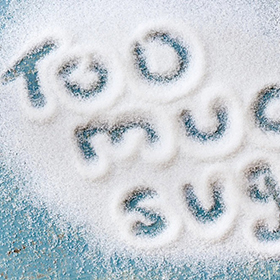
The incidence of diseases associated with a high-sugar diet has increased in the past years and numerous studies have focused on the effects of high sugar intake on the gut microbiota and its role in obesity, metabolic syndrome, CVD, cancer and other chronic inflammatory diseases.[1] But not all sugars are equal, as a fructose-rich diet appears to be more damaging to the intestinal microbiome than a sucrose-rich diet, which tends to increase weight gain.[2]
Fructose is not absorbed into the small intestine but passed through to the large intestine, where it comes into contact with the microbiome to alter species diversity.[3] Even a small dose of fructose, 0.1% (around 1g /kg), which is found in most modern foods, overwhelms the ability of the small intestine to absorb and clear it, resulting in fructose reaching the large intestine microbiome. However, the microbiome is not designed to process sugar and, as a result, can lead to dysbiosis even when the sugar is added to a normal diet.[4] Microbial diversity significantly decreases, as well as the number of commensal bacteria[5] when consuming a sugar diet—even after one week.[6] Chronic intake of fructose is associated with intestinal inflammation, leaky gut and elevated movement of toxins and other microbial products across the gut wall.[7] Fructose also worsens symptoms in irritable bowel syndrome (IBS);[8] 64% of patients suffering from IBS were not able to absorb fructose properly.[9]
Animal studies show increased liver problems when mice are fed a high-fructose diet[10] and multiple human studies have established that fructose contributes to the progression of NAFLD (non-alcoholic fatty liver disease) by modulating intestinal microbiota. In animal studies, a diet enriched with fructose not only induced NAFLD but also negatively affected the gut barrier and the microbiota, leading to dysbiosis, increased inflammation and oxidation and degrading of the mucosa barrier.[11] The liver is the first organ exposed to gut-derived toxins, receiving 70% of the blood supply from the intestine. So, the liver acts as a first line of defence against bacterial pathogens and toxins. The gut microflora has been shown to stimulate deposits of liver fat contributing to NAFLD.[12] Conversely, supplementation with probiotics and prebiotics has been shown to improve the outcome of NAFLD.[13] The form fructose comes in, whether liquid or solid, has different impacts on the gut microbiota and the integrity of the gut wall.[14]
[1] Lambertz et al., 2017.
[2] Volynets et al., 2017.
[3] Jang et al., 2018.
[4] Ferrere et al., 2016.
[5] Zhang et al., 2017.
[6] Sen et al., 2017.
[7] Rosas-Villegas et al., 2017; Lambertz et al., 2017; Volynets et al., 2017.
[8] Melchior et al., 2014.
[9] Goebel-Stengel et al., 2014.
[10] Ferrere et al., 2016.
[11] Jegatheesan et al., 2016; Lambertz et al., 2017.
[12] Mouzaki et al., 2012.
[13] Lambertz et al., 2017.
[14] Mastrocola et al., 2018.